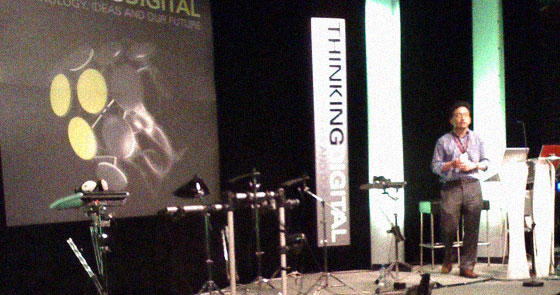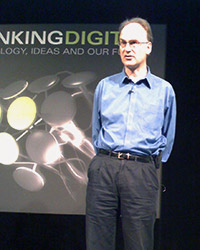Darwinian Psychology Goes Mainstream
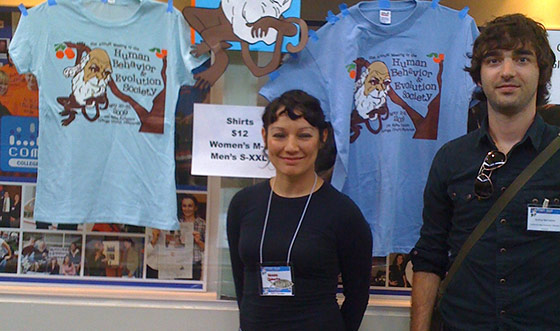
The friendly folks behind the registration counter were efficient in processing the badges for the 450+ attendees, plus selling you a t-shirt or two of primate Darwin, denoting that this year’s HBES conference celebrates the 200th anniversary of Darwin’s birth and the 150th anniversary of the publication of The Origin of Species.
On Friday May 29 I attended the 21st annual conference of the Human Behavior and Evolution Society (HBES) — the official organization of evolutionary psychologists and champions of applying Darwinian thinking to human psychology. The last HBES meeting I attended was at U.C. Santa Barbara in 1995, which was sparsely attended compared to this year’s 450+ attendees packed into tiny conference rooms for the simultaneous sessions — always a frustrating choice architecture when you want to attend more than one talk being presented at the same time. I only had a day to attend the three-day conference, so this will be necessarily unrepresentative of the remarkable body of research now being churched out by hundreds of professional evolutionary psychologists from all over the world.
I should note at the top that on this, the 200th anniversary of Darwin’s birth and the 150th anniversary of the publication of The Origin of Species, it is embarrassing that it is only now that the application of Darwinian principles are fully coming online in mainstream psychological research laboratories. In my book The Science of Good and Evil I include a history and explanation for the delay, but it still amazes me that only now has it become acceptable to include Darwin in discussions of human animal behavior. As one of the founders of the field, David Buss, likes to say (quoting, I think, Donald Symons), “evolutionary psychology” is a redundancy — given the fact that 99% of our history as a species has been spent as bipedal primates in an ancestral Paleolithic environment all psychology should be evolutionary. The fact that there is no such thing as “non-evolutionary psychology” speaks volumes, even though unofficially most psychology throughout the 20th century was just that — non-evolutionary. That problem is now coming to a close as we enter a new era of all psychology as evolutionary.
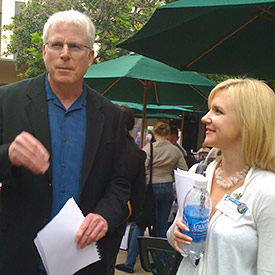
Two superstars of evolutionary psychology—David Buss from U.T. Austin and Martie Haselton from UCLA—both of whom study sexual attraction and relationships from an evolutionary perspective, confer on their latest data. In years to come Haselton will get to personally test her theories teasing apart nature and nurture on her own newly-born twins.
Incest is not Best
One of the most interesting talks of the day was by Elizabeth Pillsworth, a graduate student at UCLA in the lab of Martie Haselton, who studies sexual attraction, relationships, and how fertility cycles influence mate preferences and choices (e.g., women dress in a more sexually provocative manner during the high fertility phase of the month). In an interesting twist on this body of research, Pillsworth studied the effects of the fertility phase in women on the incest taboo — specifically, how often college-aged women phoned their dads (versus their moms) during the month. Wow. It never ceases to amaze me at how clever scientists can be in thinking up new research paradigms: who ever would have thought of correlating cell phone calls with estrus cycles? Pillsworth and Haselton (and their colleague Debra Lieberman) did! And the results were most revealing.
But first, some background. Kin affiliation in evolution is critical for predator avoidance, food procurement and sharing, protection from the elements, etc. I.e., being in a family group is extremely important for mammals. But there is an equally important downside: inbreeding. If you mate with people who are genetically similar to you, there are consequences: higher rates of infant mortality, deformed sperm, sterility, and genetic defects of all sorts — think hemophilia in the royal families of Europe in the 19th and early 20th centuries. Research shows that the offspring of 1st cousins twice as likely to suffer congenital malformation and genetic disease and up to a 5% increase in mortality; the offspring of siblings show a 45% increased risk of mortality. Thus, mammals evolved numerous adaptations for inbreeding avoidance: dispersal from natal groups (usually sex-biased), kin recognition and avoidance, extra-pair/extra-group copulations rather than copulate within their group. Pillsworth cited a study on horses that found Mares only leave the group temporarily to other breeding groups. So there’s a conflict of wanting to be close to your kin and kind, but not too close.
Hypothesis on incest avoidance: near ovulation women are motivated to avoid affiliation with male kin (fathers) but not mothers, to avoid the potential costs of inbreeding. Predictions: relative to low-fertility days, on high-fertility days women will initiate fewer calls with fathers and engage in shorter conversation with fathers, compared to mothers. The researchers had 51 normally-ovulating women (mean age 19.1) who provided complete cell phone bills from one month, along with their menstrual cycle information and details about individuals on their phone bill. Results: the subjects called their fathers significantly less than their mothers during high fertility days, and when both mothers and fathers called them during high fertility days they spent less time on the phone with their dads than their moms. Conclusion: “this is the first evidence of adaptation in human females to avoid affiliation with male kin when fertility is at its highest.”
This study was of particular interest to me because I have a 17-year old daughter who will be going off to college in a little over a year, and like most parents I’m dreading the day she is gone and I’ll lose my daily contact with her and am hoping that she calls regularly. I guess now I have to make a mental note of her high fertility days and expect fewer calls from her, but being that I’m her dad, that won’t stop me from calling her and stalling on the phone just to mess with her evolved psychology!
Sexual Hypocrisy
U.T. Austin evolutionary psychologist David Buss examined “Sexual Double Standards: The Evolution of Moral Hypocrisy.” Buss began with the well-known double standard in society that “men are socially rewarded and women socially derogated for sexual activity.” Why? Most explanations are typically culturally-determined: local social constructions, gender role expectations, American males have been culturally conditioned, cultural illusions, social learning, sexual script theory. Buss wants to know if there are adaptations that might create a sexual double standard, for example:
- Mate value assessment adaptations in men: render sexually open women less valuable as Long-Term mates, but not as Short-Term mates.
- Mate value assessment adaptations in women: render sexually successful men higher in mate value.
- Intrasexual competition adaptations in women to inflict costs on women who pursue a Short-Term mating strategy, for example, the derogation of competitors (“she’s loose” “she’s a slut”).
Are sexual double standards cross-cultural or only an artifact of modern Western society? Buss presented data from a cross-cultural study across 15 different cultures (n=2,471) that examined the impact of various acts on status and reputation. Results:
- Being a virgin and effect on status and reputation: male’s reputation does down, female’s goes up.
- Being sexually experienced on status and reputation: male’s goes up, female’s varies, but is less positive.
- Reputation as an easily accessible sexual partner: negative for both males and females.
- Having sex with a date on the first night: tends to be bad for both, but worse for females than males.
- Having sex with two people in one night: negative impact of status and reputation for both sexes, but more for women than men; Women view other women more negatively than they view men who have had sex with two people in one night.
- Being unfaithful to a Long-Term mate: decreases status for both sexes, but women more than men.
- Having an unfaithful mate: loss of status for both sexes, but more status loss for men than for women.
In other words, sexual double standards exist and are robust across cultures, and the reputational consequences are ubiquitous but worse for women than for men.
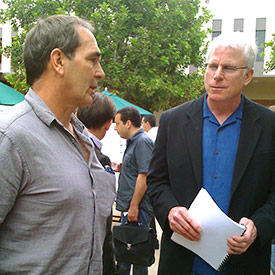
Evolutionary psychologists Steven Gangestad and David Buss chat during one of the breaks between talks. Gangestad spoke on: “Men’s Facial Masculinity, but Not Their Intelligence, Predicts Changes in Their Female partners’ Sexual Interests Across the Ovulatory Cycle” (see summary in the text), while David Buss spoke on: “Sexual Double Standards: The Evolution of Moral Hypocrisy” (see summary in the text).
Brains Alone Won’t Get you Laid
In a related talk Steven Gangstad examined: “Men’s Facial Masculinity, but Not Their Intelligence, Predicts Changes in Their Female partners’ Sexual Interests Across the Ovulatory Cycle”. If you get that title, guys, it means that being super smart will not make up for lacking a masculine face when women are in their most fertile phase of the month and in search of a sexual partner. Gangestad reviewed the literature on what fertile women find sexy in men: symmetrical face, masculine face, faces of men with high testosterone, masculine voices, social dominance, etc. When women are in estrus (their most fertile phase of the month), the patterns of attractions are a function of fertility status: during estrus women do not report being more attracted to their partners, but they do report greater attractions to extra-pair men. When women are paired with men who have less preferred partners they are more likely to stray during estrus. What about intelligence?
According to Geoffrey Miller, indicators of intelligence may have been indicators of good genes, and that perhaps big brains evolved through sexual selection because women are attracted to smart guys (this is the “brain-as-peacock-tail” theory). Unfortunately (for all the eggheads in the world!), previous studies found no correlation between intelligence and women’s sexual interest during estrus. Gangestad added facial attractiveness and facial masculinity to the equation. “Results revealed predicted effects of male partners’ facial masculinity and attractiveness, but no hint of any effect of partners’ intelligence.” Sorry all you smart cookies out there; you’ll just need to man up your face more rather than memorizing Wikipedia entries.
Selfish Heroes
Because of my interest in the evolution of morality, I first attended the session on Altruism, with an opening talk entitled “The Selfish Hero: A study of the individual benefits of self-sacrificial behavior by members of small groups” by Francis T. McAndrew. He began by explaining the evolution of altruism by “costly signaling theory,” which basically argues that people are occasionally super nice and self-sacrificial toward others (seemingly un-Darwinian) because they gain social status by so doing. That is, by doing something costly you signal to your fellow group members that you have plenty of resources and good genes, and therefore such altruistic acts may have been selected for in evolutionary history.
This, McAndrew argues, helps explain our fascination with heroes. Using 48 undergraduate subjects, 24 same-sex, three-person groups consisting of an experimental confederate and two naïve subjects participated in a ‘group decision making” study in which the success of the group depended upon the willingness of one of its members (the confederate) to endure pain and inconvenience. If the group successfully completed a series of tasks, it could divide $45 among its three members. The results confirmed that engaging in self-sacrificial costly behavior for the good of a group can be a profitable long-term strategy. The ordeal that individuals playing the role of the altruist had to endure was judged to be more difficult and costly than the experience of other group members, but in the end the altruists were rewarded with more money and higher status.
Cads and Dads
The next talk was by Julia Pradel, of the University of Cologne, entitled “Partner in Life or One-Night stand? How reproductive strategies might have shaped the evolution of altruism.” Pradel began by asking: “How could altruism — which by definition reduces an individual’s fitness — ever have evolved?” Like McAndrew, Pradel adopted costly signaling theory: “Only people high in genetic fitness can afford to help others.” Moral virtues, she said, have two signaling functions: 1. Good partnership and parenting characteristics; 2. Good genes. Thus, prosocial traits should be sexually attractive, and therefore sexual selection plus costly signaling theory explains altruism. If so, then why do people differ in altruistic tendencies? Pradel’s answer can be found in the theory of strategic pluralism: both sexes possess psychological adaptations for both short term relationships and long term relationships. Preferences for long-term as opposed to short-term relationships vary among individuals (e.g., women choose between “Cads” and “Dads”). Perhaps altruism was a means to compensate for weaknesses in genetic quality (e.g., lack of physical attractiveness). Mixed reproductive strategies suggest distinctive mate preferences depending on the length of sexual relationship (short-term v. long-term).
Hypothesis 1: Altruism serves as a signal of both good partnership/parenting and good genes, and thus it is perceived sexually attractive in both potential short-term and long-term. Hypothesis 2: Altruism will be a signal for long-term relationships only.
170 raters watched short video-clips of target persons with varying physical attractiveness and received additional information on the targets’ level of altruism. In a between-subjects-design, raters indicated their desire to win the targets as either (a) short-term mates or (b) long-term mates. While altruism was a significant predictor for long-term desire, it was irrelevant for rating short-term mates. The results suggest that although altruism is costly, at least for some individuals it might be a wretched necessity to obtain access to mates and to reproduce.
Smile, You’re On Candid Camera
Related to these findings, Mizuho Shinada and Toshio Yamagishi examined “Trust and Detection of Trustworthiness.” They began by noting that if altruists choose partners randomly, the average payoff to defectors will always exceed the average payoff to cooperators, therefore altruists cannot survive in evolutionary history. However, if altruists can distinguish altruists from non-altruists, altruists will choose altruists and build cooperative relationships, and thus altruists will get a higher payoff by cooperative interaction with altruists. Therefore, people should be able to distinguish altruists from non-altruists by facial expressions, such as the ability to tell the difference between a fake smile and a genuine smile (it has to do with the eyes: a genuine smile usually includes a slight squinting of the eyes whereas a fake smile does not). Thus, only altruists should have altruism-detection skills because altruists would be chosen as interaction partners if people can detect altruists from non-altruists, and non-altruists cannot be chosen by altruists even if they can detect altruists. To date, however, no study has reported that altruists are more accurate than non-altruists in detecting cheaters or altruists. Why?
One answer: the co-evolution of trust and altruism-detection. Altruists who don’t trust strangers don’t want to leave the current relationship and seek a new partner. Those who don’t trust strangers don’t have alternatives from which to choose — the ability to tell cooperators from defectors is of no use for them since they have no alternative to choose from. Those who trust strangers should have altruism-detection abilities. To these these hypotheses, Shinada and Yamagishi first had 47 males and 53 females (average age of 48) answer a questionnaire that included a trust scale consisting of five items, then showed them faces of genuine or fake smiles (20 faces total, 10 real and 10 fake smiles). Results: participant’s trust level positively correlated with the detection accuracy of genuine smile (r = 0.39, p<.0001), and high trusters are more accurate in distinguishing genuine smile from fake smiles when compared to low trusters.
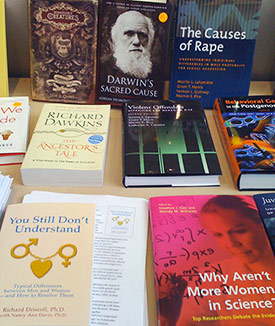
Three six-foot tables were chockablock full of books on evolutionary psychology, indicate just how far this science has grown in the past decade. Monographs, textbooks, and popular trade books provide something for everyone who wants to know more about why we behave as we do from a Darwinian perspective.
In a second study, Shinada and Yamagishi had participants (perceivers, n=99) watched 5-second video-clips. The videos were filmed while the other participants (targets, n=102) played a Trust Game. Before the experiment, they measured the perceiver’s trust level using a questionnaire. They found positive correlations between the perceiver’s trust level, “trustworthy bias” (i.e., the frequency that perceivers judged targets as trustworthy), and age: high-trusters and elderly perceivers tended to expect that most people were trustworthy. Furthermore, the perceivers trust level was positively correlated with the detection accuracy of trustworthiness when they controlled for the perceiver’s age: high-trusters were able to detect the trustworthiness of others with more accuracy than low-trusters.
Conclusions: adaptive advantages of altruism detection exists only when actors choose potential alternative partners, and high trusters who are willing to choose new partners were more accurate in detecting other’s trustworthiness via facial expressions than low-trusters were.


